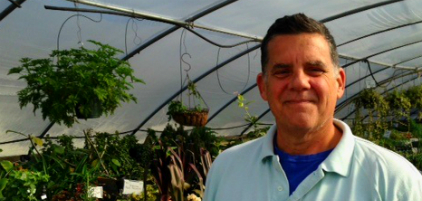As we head into a 2018 which will probably bring us the usual ex-
tremes in temperatures and conditions, it seems that this should be
a time for us all to modify and tweak our gardening techniques to
meet this challenge.
One method I have found that works very effectively on my farm
is called trench composting.
It has a fairly simple set-up, takes most of the work out of compost-
ing, and could help to create bountiful crops in all of the organic
vegetable patches in Hays County. The only tool that you need is
a shovel.
The hardest part is the digging of the trench, which can range from
3 feet to 6 inches deep. The depth which you dig will depend on
the depth of your soil, and your physical energy.
Dig down what you can remove with ease. Then soak the trench
and come back two days later and proceed to remove the soil to the
depth that you want. The trench only needs to be one shovel blade
wide for community garden sites.
After digging and throwing the soil onto the adjacent bed you can
now start filling in your trench with whatever material you have
available. Putting corn and okra stalks on the bottom, then a foot
layer of grass clippings will ensure the stalks of heating up.
Additional materials could be leaves, hay, woodchips and other
garden debris. Fill the trench up to the top of the bed before you
start digging your bed. If you start digging the bed before the
trench is filled the sides will collapse.
After filling it in, treat the trench as a pathway to walk on, and in
6 months the materials will have decomposed. All it takes then
is a simple shoveling of the compost onto the planting bed, then
filling in the trench before incorporating the compost into your bed.
This method is a time-saver if used correctly. Even with a cold front
passing by, you can loosen up the trench with a tiller or digging fork,
then cover your whole garden with row cover and you’ll save your
crops from freezing. The heat will permeate up from the trench but
will be trapped by the row cover.
____________________________________________________
The Benefits of Trench Composting
1 Time saved because you will not have to turn material.
2. With the addition of organic material directly into the ground
the root systems of squashes, tomatoes, basil and okra will alter
their growth towards and under the trench.
3. Rain and watering your trench will leach out nutrients for the
established plants.
4. You will not get muddy feet when walking on the trench path-
way that was filled with leaves.
5. Heat generated from decomposition will warm your garden dur-
ing cold periods.
6. This is a method for stockpiling lots of leaves.
7. For community gardeners who leave their garden, the next gard-
ener will have a supply of compost on hand.
8. Trenches are not unsightly like most compost bins and materials
are needed to build it other than a shovel.
9. Weeds will not grow in the trenches.
10. Compost is right next to the garden bed. No more hauling com-
post around in wheelbarrows. Happy gardening everyone! ❦
Certified Organic Millberg Farm in Kyle is operated by Tim Miller







